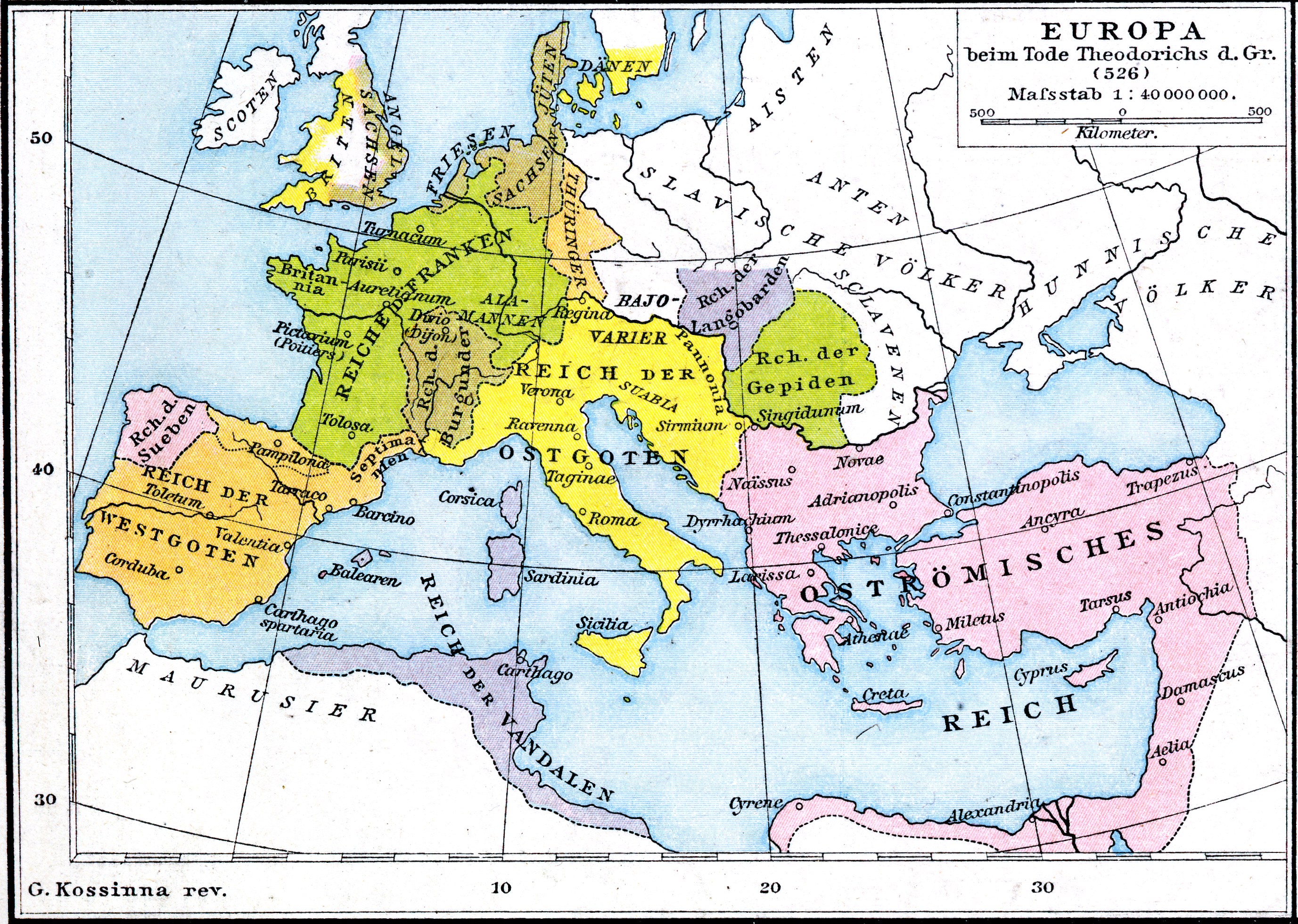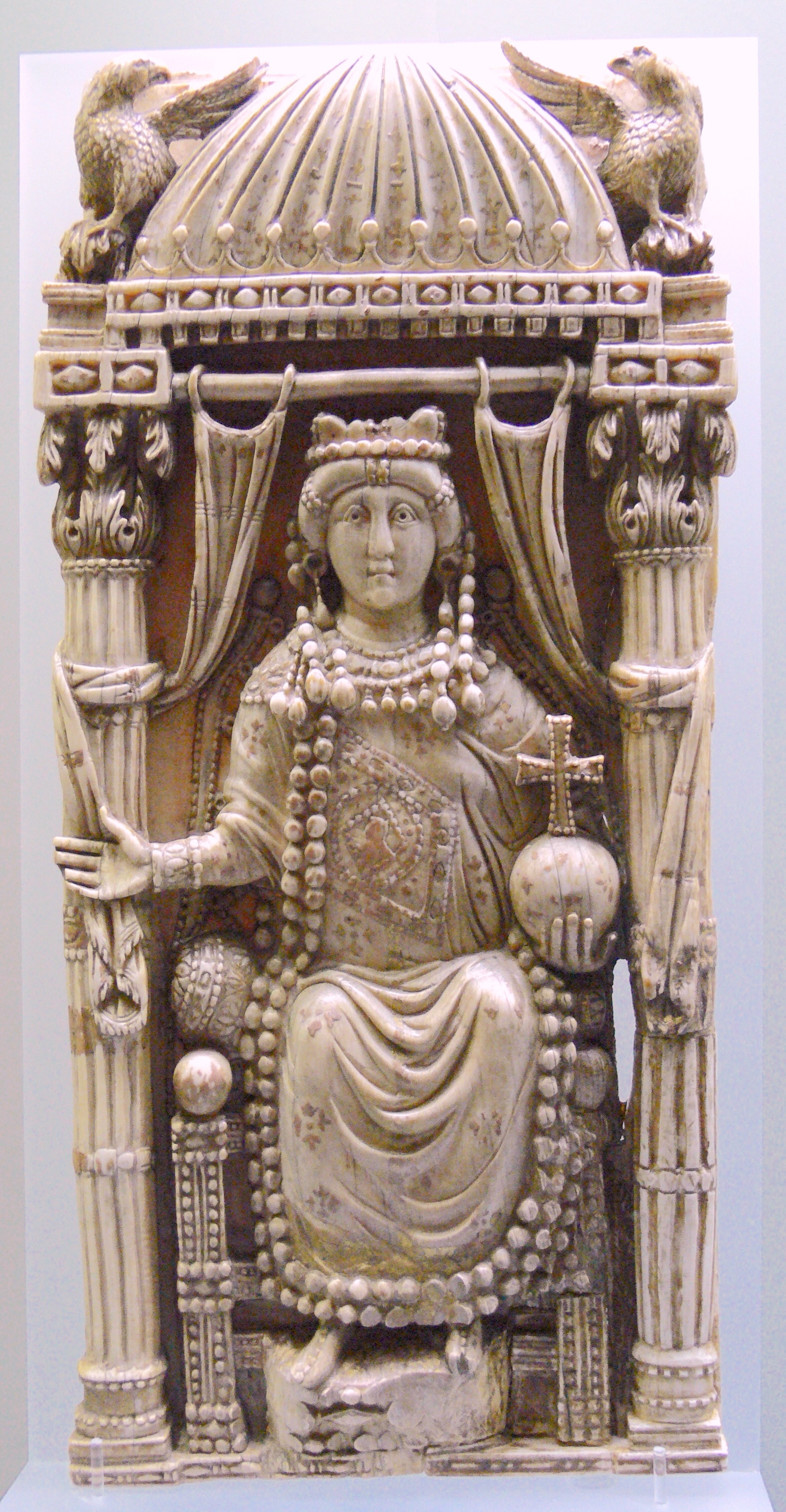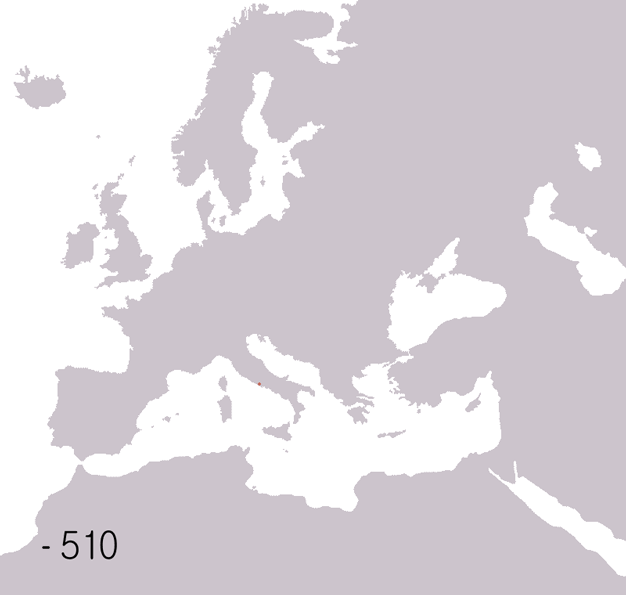|
Odoacer
Odoacer ( – 15 March 493 AD), also spelled Odovacer or Odovacar, was a barbarian soldier and statesman from the Middle Danube who deposed the Western Roman child emperor Romulus Augustulus and became the ruler of Italy (476–493). Odoacer's overthrow of Romulus Augustulus is traditionally understood as marking the end of the Western Roman Empire. Although he held power over Italy, he also represented himself as the client of the Eastern Roman Emperor in Constantinople, Zeno. He was referred to not only as a king (), but also as commander (), or using the Roman honorific patrician, granted by Zeno. Odoacer himself used the title of king in the only surviving official document that emanated from his chancery, and it was also used by the consul Basilius. He had the support of the Roman Senate and was able to distribute land to his followers without much opposition. Unrest among his soldiers led to violence in 477–478, but no such disturbances occurred during the later p ... [...More Info...] [...Related Items...] OR: [Wikipedia] [Google] [Baidu] [Amazon] |
Western Roman Empire
In modern historiography, the Western Roman Empire was the western provinces of the Roman Empire, collectively, during any period in which they were administered separately from the eastern provinces by a separate, independent imperial court. Particularly during the period from AD 395 to 476, there were separate, coequal courts dividing the governance of the empire into the Western provinces and the Eastern provinces with a distinct Line of hereditary succession, imperial succession in the separate courts. The terms Western Roman Empire and Byzantine Empire, Eastern Roman Empire were coined in modern times to describe political entities that were ''de facto'' independent; contemporary Ancient Rome, Romans did not consider the Empire to have been split into two empires but viewed it as a single polity governed by two imperial courts for administrative expediency. The Western Empire collapsed in 476, and the Western imperial court in Ravenna disappeared by AD 554, at the end of Ju ... [...More Info...] [...Related Items...] OR: [Wikipedia] [Google] [Baidu] [Amazon] |
Scirian
The Sciri, or Scirians, were a Germanic people. They are believed to have spoken an East Germanic language. Their name probably means "the pure ones". The Sciri were mentioned already in the late 3rd century BC as participants in a raid on the city of Olbia near modern-day Odesa. In the late 4th century they lived somewhere north of the Black Sea and Lower Danube in the vicinity of the Goths. By the early 5th century, the Sciri had been subdued by the Huns, whom they fought under at the Battle of the Catalaunian Plains in 451 AD. After the death of Attila, the Sciri broke free from Hunnic rule at the Battle of Nedao in 454 AD. They subsequently were recorded holding their own kingdom north of the Middle Danube, under the leadership of Edeko and his son Onoulphus. After the destruction of this kingdom by the Ostrogoths in the late 460s AD, Odoacer, another son of Edeko, attained high status within the Roman army in Italy, ruling Sciri, Rugii and other non-Roman peoples as a ... [...More Info...] [...Related Items...] OR: [Wikipedia] [Google] [Baidu] [Amazon] |
Romulus Augustulus
Romulus Augustus (after 511), nicknamed Augustulus, was Roman emperor of the Western Roman Empire, West from 31 October 475 until 4 September 476. Romulus was placed on the imperial throne while still a minor by his father Orestes (father of Romulus Augustulus), Orestes, the , for whom he served as little more than a figurehead. After a rule of ten months, the barbarian general Odoacer defeated and killed Orestes and deposed Romulus. As Odoacer did not proclaim any successor, Romulus is typically regarded as the last Western Roman emperor, his deposition marking the Fall of the Western Roman Empire, end of the Western Roman Empire as a political entity. The deposition of Romulus Augustulus is also sometimes used by historians to mark the transition from Classical antiquity, antiquity to the medieval period. Very few records survive of Romulus's reign. There are no known policies, laws or inscriptions of significance of the emperor, which leaves the impression that he was a shado ... [...More Info...] [...Related Items...] OR: [Wikipedia] [Google] [Baidu] [Amazon] |
Theodoric The Great
Theodoric (or Theoderic) the Great (454 – 30 August 526), also called Theodoric the Amal, was king of the Ostrogoths (475–526), and ruler of the independent Ostrogothic Kingdom of Italy between 493 and 526, regent of the Visigoths (511–526), and a patrician (ancient Rome)#Late Roman and Byzantine period, patrician of the Byzantine Empire#Loss of the Western Roman Empire, Eastern Roman Empire. As ruler of the combined Gothic realms, Theodoric controlled an empire stretching from the Atlantic Ocean to the Adriatic Sea. Though Theodoric himself only used the title 'king' (''rex''), some scholars characterize him as a Roman Emperor#Later assertions to the title, Western Roman emperor in all but name, since he ruled a large part of the former Western Roman Empire described as a ''Res Publica'', had received the former Western imperial regalia from Constantinople in 497 which he used, was referred to by the imperial title ''princeps'' by the Italian aristocracy and exercised imper ... [...More Info...] [...Related Items...] OR: [Wikipedia] [Google] [Baidu] [Amazon] |
Zeno (emperor)
Zeno (; ; – 9 April 491) was Eastern Roman emperor from 474 to 475 and again from 476 to 491. His reign was plagued by domestic revolts and religious dissension, but was more successful on the foreign front. He is credited with further stabilizing the Eastern empire, while the Western Roman Empire fell following the deposition of Romulus Augustulus. Born in Isauria, Zeno was known as Tarasis before adopting his Greek name and becoming an ally of Emperor Leo I (emperor), Leo I, who saw the Isaurian general as an important counterweight against the Germanic leader Aspar. In 466, he married Leo I's daughter, Ariadne (empress), Ariadne, with whom he had a son, Leo II (emperor), Leo. On the death of Leo I in 474, Zeno's seven-year-old son took the throne as Leo II, with Zeno made co-emperor shortly after. Leo II died of an illness later that year, leaving Zeno as the sole emperor. Despite his early success in making peace with the Vandals, Zeno was an unpopular emperor due to his ... [...More Info...] [...Related Items...] OR: [Wikipedia] [Google] [Baidu] [Amazon] |
Fall Of The Western Roman Empire
The fall of the Western Roman Empire, also called the fall of the Roman Empire or the fall of Rome, was the loss of central political control in the Western Roman Empire, a process in which the Empire failed to enforce its rule, and its vast territory was divided among several successor polities. The Roman Empire lost the strengths that had allowed it to exercise effective control over its Western provinces; modern historians posit factors including the effectiveness and numbers of the army, the health and numbers of the Roman population, the strength of the economy, the competence of the emperors, the internal struggles for power, the religious changes of the period, and the efficiency of the civil administration. Increasing pressure from invading peoples outside Roman culture also contributed greatly to the collapse. Climatic changes and both endemic and epidemic disease drove many of these immediate factors. The reasons for the collapse are major subjects of the hi ... [...More Info...] [...Related Items...] OR: [Wikipedia] [Google] [Baidu] [Amazon] |
Heruli
The Heruli (also Eluri, Eruli, Herules, Herulians) were one of the smaller Germanic peoples of Late Antiquity, known from records in the third to sixth centuries AD. The best recorded group of Heruli established a kingdom north of the Middle Danube, probably including the area north of present day Vienna. This kingdom was a neighbour to several other small and short-lived kingdoms in the late 5th century AD and early 6th century, including those of the Sciri, Rugii, Danubian Suebi, and Gepids. After the conquest of this Heruli kingdom by the Lombards in 508, splinter groups moved to Sweden, Ostrogothic Italy, and present-day Serbia, which was under Eastern Roman control. The Danubian Heruli are generally equated to the "Elouri" who lived near the Sea of Azov during the late 3rd or early 4th century, and are believed to have migrated westwards. In 267-270 these Elouri took part together with Goths and other eastern European peoples in two massive raids into Roman provinces in ... [...More Info...] [...Related Items...] OR: [Wikipedia] [Google] [Baidu] [Amazon] |
Ravenna
Ravenna ( ; , also ; ) is the capital city of the Province of Ravenna, in the Emilia-Romagna region of Northern Italy. It was the capital city of the Western Roman Empire during the 5th century until its Fall of Rome, collapse in 476, after which it served as the capital of the Ostrogothic Kingdom and then the Byzantine Exarchate of Ravenna. It has 156,444 inhabitants as of 2025.Initially settled by the Umbri people, Ravenna came under Roman Republic control in 89 BC. Augustus, Octavian built the military harbor of Classe, ancient port of Ravenna, Classis at Ravenna, and the city remained an important seaport on the Adriatic Sea, Adriatic until the early Middle Ages. The city prospered under imperial rule. In 401, Western Roman emperor Honorius (emperor), Honorius moved his court from Mediolanum to Ravenna; it then served as capital of the empire for most of the 5th century. After the fall of the Western Roman Empire, Ravenna became the capital of Odoacer until he was defeated by ... [...More Info...] [...Related Items...] OR: [Wikipedia] [Google] [Baidu] [Amazon] |
Christianity As The Roman State Religion
In the year before the First Council of Constantinople in 381, Nicean Christianity became the official religion of the Roman Empire when Theodosius I, emperor of the East, Gratian, emperor of the West, and Gratian's junior co-ruler Valentinian II issued the Edict of Thessalonica in 380, which recognized the catholic orthodoxy, as defined by the Council of Nicea, as the Roman Empire's state religion. Historians refer to the imperial church in a variety of ways: as the catholic church, the orthodox church, the imperial church, the Roman church, or the Byzantine church, although some of those terms are also used for wider communions extending outside the Roman Empire. The Eastern Orthodox Church, Oriental Orthodoxy, and the Catholic Church all claim to stand in continuity from the Nicene church to which Theodosius granted recognition. Political differences between the Eastern Roman Empire and the Persian Sassanid Empire led to the separation of the Church of the East in 424. Doctrina ... [...More Info...] [...Related Items...] OR: [Wikipedia] [Google] [Baidu] [Amazon] |
Rugian
The Rugii, Rogi or Rugians (), were one of the smaller Germanic peoples of Late Antiquity who are best known for their short-lived 5th-century kingdom upon the Roman frontier, near present-day Krems an der Donau in Austria. This kingdom, like those of the neighbouring Heruli and Sciri, first appears in records after the death of Attila in 453. The Rugii, Heruli, Sciri and others are believed to have moved into this region from distant homelands under pressure from the Huns, and become part of Attila's Hunnic empire which also moved and came to be based in this region. The Rugii were subsequently part of the alliance which defeated Attila's sons and the Ostrogoths at the Battle of Nedao in 454, giving their kingdom independence. In 469 they were part of a similar alliance who lost to the Ostrogoths at the Battle of Bolia, weakening their kingdom significantly. Many Rugii, once again along with Sciri, Heruli and other Danubians, joined Odoacer in Italy and became part of his king ... [...More Info...] [...Related Items...] OR: [Wikipedia] [Google] [Baidu] [Amazon] |
Edeko
By the name Edeko (with various spellings: Edeco, ''Edeko'', ''Edekon'', ''Edicon'', ''Ediko'', ''Edica'', ''Ethico'') are considered three contemporaneous historical figures, whom many scholars identify as one: *A prominent Hun, who served as both Attila's deputy and his ambassador to the Byzantine Empire (in 449). According to sources of the time, he distinguished himself for courage and skill in the battles of Naissus and the Uthus river, during the invasion of the Eastern Roman Empire, thus becoming part of Attila's circle of favorite advisors, so much so that he put him in charge of a diplomatic mission in Constantinople, where the court treasurer, Chrysaphius, tried to bribe him to assassinate his king. Edeco seemed to agree, but as soon as he reached Attila's court he informed him of the plan and the Hun monarch unmasked the Roman ambassador. *Idikon or Edico, the father of Odoacer, who became a magister militum in the Roman Army and the first King of Italy (476–493). Th ... [...More Info...] [...Related Items...] OR: [Wikipedia] [Google] [Baidu] [Amazon] |
Roman Senate
The Roman Senate () was the highest and constituting assembly of ancient Rome and its aristocracy. With different powers throughout its existence it lasted from the first days of the city of Rome (traditionally founded in 753 BC) as the Senate of the Roman Kingdom, to the Senate of the Roman Republic and Senate of the Roman Empire and eventually the Byzantine Senate of the Eastern Roman Empire, existing well into the post-classical era and Middle Ages. During the days of the Roman Kingdom, the Senate was generally little more than an advisory council to the king. However, as Rome was an electoral monarchy, the Senate also elected new Roman kings. The last king of Rome, Lucius Tarquinius Superbus, was overthrown following a coup d'état led by Lucius Junius Brutus, who founded the Roman Republic. During the early Republic, the Senate was politically weak, while the various executive Roman magistrates who appointed the senators for life (or until expulsion by Roma ... [...More Info...] [...Related Items...] OR: [Wikipedia] [Google] [Baidu] [Amazon] |







